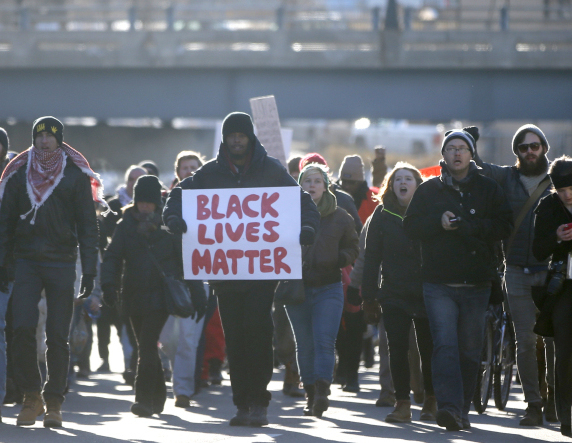From the White House to the streets of some of America’s biggest cities, the New York chokehold case converged with the Ferguson shooting and investigations out of South Carolina and Cleveland to stir a national conversation Thursday about racial justice and police use of force.
A day after a grand jury cleared a white New York City officer in the death of a black man, civil rights leaders pinned their hopes on a promised federal investigation. Demonstrators protested for a second night in New York, carrying replicas of coffins across the Brooklyn Bridge, and turned out in such cities as Denver, Detroit and Minneapolis. And politicians and others talked about the need for better police training, body cameras and changes in the grand jury process to restore faith in the legal system.
“A whole generation of officers will be trained in a new way,” New York Mayor Bill de Blasio vowed as he and his police commissioner outlined previously announced plans to teach officers how to communicate better with people on the street.
President Obama weighed in, saying one of the chief issues is “making sure that people have confidence that police and law enforcement and prosecutors are serving everybody equally.”
Even before the decision in the Eric Garner case came down, racial tensions were running high because of last week’s grand jury decision not to charge a white officer in the shooting death of black 18-year-old Michael Brown in Ferguson, Missouri.
Other cases were added to the mix on Thursday:
• In the tiny South Carolina town of Eutawville, a white former police chief was charged with murder in the 2011 shooting of an unarmed black man. Richards Combs’ lawyer accused prosecutors of taking advantage of national outrage toward police to obtain the indictment more than three years after the killing.
• In Cleveland, the U.S. Justice Department and the city reached an agreement to overhaul the police department after federal investigators found that officers use excessive force far too often, causing deep mistrust, especially among blacks. The investigation was prompted chiefly by a 2012 police car chase that ended in the deaths of two unarmed people in a hail of 137 bullets.
Just last week, protesters took to the streets of Cleveland after a white police officer shot and killed a black 12-year-old boy carrying what turned out to be pellet gun.
At a news conference in New York after a night of protests led to 83 arrests, the Rev. Al Sharpton called the state-level grand jury system “broken” and urged Washington to fix it.
“The federal government must do in the 21st century what it did in the mid-20th century,” he said. “Federal intervention must come now and protect people from state grand juries.”
Still, federal civil rights cases against police officers are exceedingly rare.
In the past two decades, only a few such cases have reached trial in New York – most notably the one involving Abner Louima, who was sodomized with a broom handle in a police station in 1997. Several other high-profile cases didn’t come together.
That’s largely because federal prosecutors must meet a high standard of proof in showing that police deliberately deprived victims of their civil rights through excessive force, said Alan Vinegrad, who as a federal prosecutor handled the Louima case.
Federal intervention “doesn’t happen often and it shouldn’t happen often,” said James Jacobs, a constitutional law professor at New York University Law School. “They should only step in when the local prosecution was a sham.”
Activists have claimed that the grand jury probe of Garner’s death was a sham. An amateur video showed Officer Daniel Pantaleo putting Garner in an apparent chokehold, and the medical examiner said the maneuver contributed to the death.
Acting at the Staten Island district attorney’s request, a judge released a few details Thursday from the grand jury proceedings – among other things, it watched four videos and heard from 50 witnesses, 22 of them civilians. District Attorney Daniel Donovan didn’t ask for exhibits to be made public.
But Pantaleo’s attorney, Stuart London, offered details, saying the officer’s testimony focused on “his remorse and the fact that he never meant to harm Mr. Garner that day.”
Pantaleo admitted he heard Garner say, “I can’t breathe,” but believed that once he got him down on the ground and put him on his side, he would be revived by paramedics, London said. The officer also testified that he “used a takedown move and any contact to the neck was incidental,” the lawyer added.
London said the grand jury also heard from other officers who described how Pantaleo had tried in vain to talk Garner into complying with them – something not seen on video.
“Let’s make this easy. You’ve been through this before,” the officer said he told Garner.
Gov. Andrew Cuomo said the Garner case and others like it have a “corrosive” effect and cause many to lose faith in the criminal justice system.
Send questions/comments to the editors.



Success. Please wait for the page to reload. If the page does not reload within 5 seconds, please refresh the page.
Enter your email and password to access comments.
Hi, to comment on stories you must . This profile is in addition to your subscription and website login.
Already have a commenting profile? .
Invalid username/password.
Please check your email to confirm and complete your registration.
Only subscribers are eligible to post comments. Please subscribe or login first for digital access. Here’s why.
Use the form below to reset your password. When you've submitted your account email, we will send an email with a reset code.